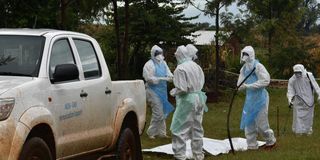Marburg virus fears grip Namanga border town

Ministry of Health officials in protective gear meant to combat disease outbreak. The government is on high alert following reported deaths related to the Marburg virus in Bukoba, Tanzania.
What you need to know:
- The World Health Organization (WHO) describes the Marburg virus as highly virulent and say it causes a hemorrhagic fever, with a fatality rate of up to 88 per cent.
- The virus is transmitted to people from fruit bats and spreads among humans through direct contact with the bodily fluids of infected people, surfaces and materials.
Fears about the deadly Marburg virus disease have gripped the Kenya-Tanzania border town of Namanga, days after cases were reported in the neighbouring country.
The border town residents want the Kenyan government to implement measures to prevent the spread of the virus.
A Nation spot check at the border on Friday morning found operations, including traveller checks, going on normally at the border crossing point.
Kenyan authorities remained tight-lipped on measures put in place to curb any possible spread of the virus.
Tanzanian authorities were seemingly on high alert, preventing media personnel from approaching and taking pictures.
The fear in Kenya is because traders and residents interact freely at the border. In addition, Kenya shares another border point with Tanzania - at Tarakea in Loitoktok and there are dozens of clandestine entry points along the porous border.
Mr Duncan Mboya, a trader in Namanga, said the government must implement measures similar to those undertaken to fight the Covid-19 pandemic.
"We hear the disease is a killer. Let our government take caution before it finds its way into Kenya," he said.
Trucks drivers, especially those ferrying goods from Tanzania into Kenya, also registered their fears over the disease.
"We don't know much about this disease but we would like the two authorities to work hand in hand to contain its further spread," said Abdi Addulahi, a truck driver.
Two days ago, Tanzania confirmed its first-ever cases of the Marburg virus disease after laboratory tests were carried out following reports of infections and deaths in the country’s north-west Kagera region.
Tanzania's health minister, Ummy Mwalimu, said the mysterious and deadly outbreak in its northwest Kagera region was caused by the Marburg virus.
The World Health Organization (WHO) describes the Marburg virus as highly virulent and say it causes a hemorrhagic fever, with a fatality rate of up to 88 per cent. It is in the same family as the Ebola virus disease.
The illness caused by the Marburg virus begins abruptly, with a high fever, a severe headache and severe malaise. For many patients, serious hemorrhagic symptoms develop within seven days.
The virus is transmitted to people from fruit bats and spreads among humans through direct contact with the bodily fluids of infected people, surfaces and materials.
There are no vaccines or antiviral treatments approved to treat the virus. However, supportive care – rehydration with oral or intravenous fluids – and treatment of specific symptoms, improves chances of survival.





